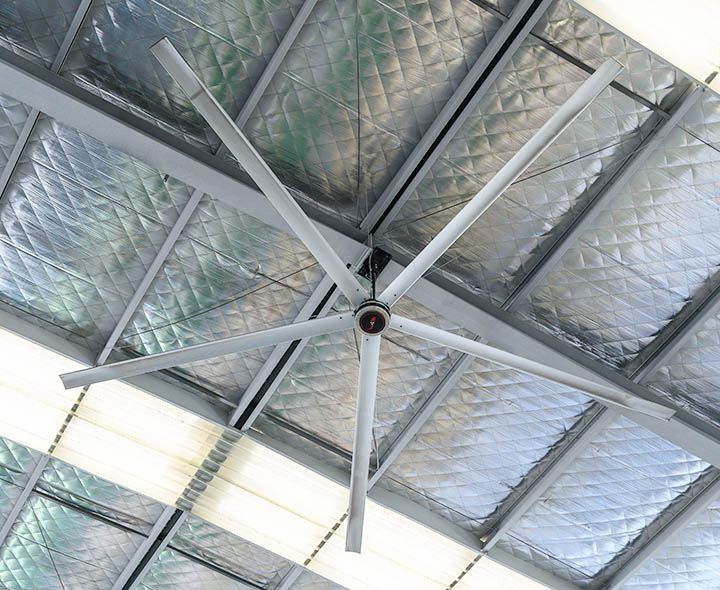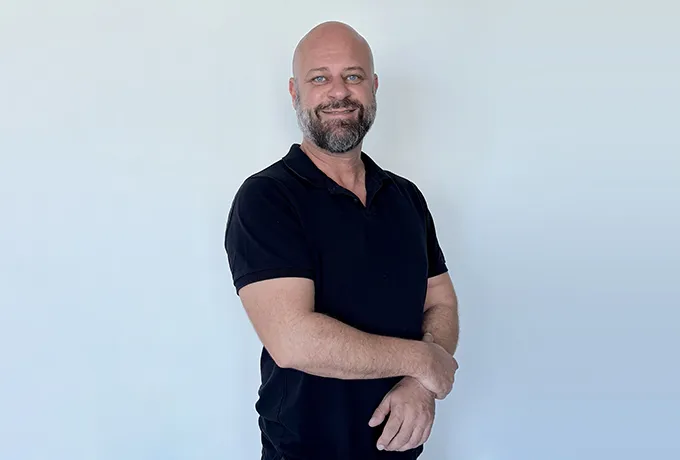Big rooms get hot. Workers feel tired. Air does not move well. Energy bills keep going up. Does this sound like your building?
You are not alone. Every day, thousands of warehouse managers, factory owners, Und facility directors face the same problem. Poor air flow makes people uncomfortable. It wastes money. And it hurts how much work gets done.
But here is the good news. There is a simple fix. It is called a High-Volume Low-Speed (HVLS) fan. Diese industrielle Deckenventilatoren are changing how we cool and heat big spaces. They work quietly. They save money. And they make people feel better at work.
Let me show you how.
Walk into any Lager, manufacturing facility, oder Sporthalle on a hot day. What do you feel?
Hot air rises to the ceiling. Cold air stays near the floor. The middle feels stuffy. Your HLK-Anlage runs all day. But people still complain.
In winter, the problem gets worse. Your heater pumps warm air into the room. But all that heat floats up to the ceiling. The floor stays cold. Workers wear jackets indoors. Your heating bills skyrocket.
This is called thermal stratification. It happens in every building with high ceilings. And it costs you money every single month.

thermal stratification
Let me share some numbers. Studies show that poor Luftzirkulation can:
Eins logistics company tracked their energy bills for a year. They spent over $50,000 on cooling alone. Their warehouse had no air movement systems. The air just sat there, hot and heavy.
Does this sound familiar? If so, keep reading.
Bad air flow is not just uncomfortable. It creates real business problems.
Dein HVAC supplement systems work overtime. They pump cold air in summer. They blast heat in winter. But most of that conditioned air never reaches your workers.
The result? You pay for air conditioning that does not cool. You pay for heating that does not warm.
When people feel too hot, they slow down. Their focus drops. Mistakes go up. Studies prove that thermischer Komfort directly affects how much work gets done.
In one Verteilzentrum, workers reported feeling exhausted by midday. The building had no facility cooling equipment. Productivity dropped by 15% on hot days.
Schlecht Luftqualität creates moisture. Moisture creates condensation. Condensation damages products. In cold storage facilities, this can ruin entire shipments.
Nobody wants to work in an uncomfortable building. When your facility feels like an oven in summer or an icebox in winter, good workers leave. You spend more time and money hiring and training replacements.
The question is: How long will you let this continue?
Here is where industrielle Deckenventilatoren change the game. Specifically, HVLS-Ventilatoren (High-Volume Low-Speed fans).
These are not your regular ceiling fans. They are large-diameter industrial fans engineered to move massive amounts of air across huge spaces—quietly, efficiently, and affordably.

Was macht die HVLS-Ventilatoren anders?
Traditional fans spin fast. They move air in a small area. They are loud.
HVLS-Deckenventilatoren work the opposite way. They spin slowly. But their large commercial fans blades (typically 7 to 24 feet across) push a huge column of air downward. That air spreads out across the floor, creating a gentle breeze that covers thousands of square feet.
This is called air flow optimization. And it solves all the problems we just talked about.
Let me explain the science in simple terms.
When air moves over your skin, it helps sweat evaporate. This makes you feel cooler—even when the actual temperature stays the same.
HVLS-Ventilatoren create a constant, gentle breeze. This Verdunstungskühlung effect makes people feel 7 to 11 degrees Fahrenheit cooler without changing the thermostat.
What does this mean for you? You can set your air conditioner to a higher temperature. Your cooling cost reduction technology kicks in. Energy bills drop by bis zu 30%.
| Metrisch | Ergebnis |
| Perceived Temperature Drop | 7-11°F cooler |
| Cooling Cost Savings | Bis zu 30% |
| Energieeinsatz | Pennies per hour |
In winter, industrielle Deckenventilatoren für die Fertigung reverse direction. Instead of pushing air down, they pull air up gently. This mixes the warm ceiling air with the cooler floor air.
This process is called de-stratification. It eliminates hot and cold spots. Your entire space reaches an even temperature.
The result? Your heater runs less often. You save up to 20% on heating costs.
Let me break down exactly what HVLS industrial solutions do for your business.
We already covered the numbers. But let me say it again:
Most companies see a return on investment (ROI) within 6 months to 2 years.
Industrial air circulators do more than cool. They:
This creates a safer, healthier workplace. It is especially important in automotive shops, agricultural barns, Und food processing plants.
Comfortable workers are productive workers. When people feel good, they:
Eins manufacturing facility installed HVLS-Ventilatoren für Lagerhallen operations. Within three months, they measured a noticeable improvement in employee satisfaction scores.
You might think a 24-foot fan would sound like an airplane. But you would be wrong.
Low-speed air movement means these fans are incredibly quiet. Most quiet fans for sport centers operate at less than 50 decibels—about as loud as a normal conversation.
Heavy-duty fans are made from aircraft-grade blades, stainless steel housing, Und corrosion-resistant materials. They have few moving parts. This means:
Many models now use gearless HVLS technology mit direct drive motors. This eliminates the need for belt changes and gear oil.
Not all industrielle Deckenventilatoren are created equal. Here is how to pick the right one for your space.
The size of your fan depends on:
Here is a simple guide:
| Space Size (sq. ft.) | Empfohlener Lüfterdurchmesser |
| Up to 2,000 | 7-9 feet |
| 2,000-5,000 | 10-14 feet |
| 5,000-10,000 | 14-18 Fuß |
| 10,000-20,000 | 18-24 feet |
| 20,000+ | Multiple large fans |
For example, a typical 50,000 sq. ft. warehouse might need 4 to 6 beste HVLS-Fans strategically placed for full coverage.
Sie haben im Wesentlichen zwei Möglichkeiten:
Direct Drive Motors:
Geared Motors:
For most applications, direct drive is the smarter long-term choice.
Modern blade aerodynamics matter. Look for:
These features maximize air velocity while minimizing power consumption.
Options range from basic to smart:
Many facilities now use motion-activated fans in areas with intermittent use to save even more energy.
Commercial-grade HVLS fans work in almost any large space. But they shine in certain applications.
Lagerhaus HVLS-Ventilatoren eliminate hot spots. They keep inventory at stable temperatures. And they make material handling safer and more comfortable.
Big industrial fans for manufacturing Hilfe bei Klimatisierung, fume dissipation, and worker comfort. They reduce the load on expensive industrial air conditioning Systeme.
High bay fans keep athletes and spectators comfortable. They reduce humidity. And they operate quietly enough not to disrupt games or practices.
Barn ventilation is critical for animal health. Großvolumige Deckenventilatoren für die Landwirtschaft reduce heat stress in livestock, improve air quality, and minimize odors.
Industrial exhaust systems combined with HVLS fans for automotive applications help clear fumes and regulate temperature in repair bays.

Anwendung von HVLS-Ventilatoren
Plant ventilation solutions in hotels, airports, and convention centers benefit from big commercial ceiling fans for commercial buildings. These fans provide comfort without the high costs of traditional HVAC.
Let me share a real example. A large logistics and warehousing operation struggled with high energy costs and poor air circulation.
Their 80,000 sq. ft. facility had:
They installed six kommerzielle Deckenventilatoren—specifically, HVLS-Deckenventilatoren with direct drive motors.
Within the first year:
Der payback period was just 14 months. Every year after that is pure savings.
Not all industrial fan systems are equal. The technology behind the fan makes a huge difference.
Modern high-torque motor fans deliver more power with less electricity. Direct drive systems eliminate friction losses. And motor efficiency ratings have improved dramatically in recent years.
Engineers use wind tunnel testing Und air velocity maps to design blades that move the most air with the least power. Aircraft-grade blades are strong, light, and perfectly balanced.
Vibration-dampening technology ensures smooth, quiet operation even at large diameters. This extends the life of both the fan and your building structure.
The best integrated ventilation systems connect your fans to your Heizungs-, Lüftungs- und Klimatechnik Und smart thermostats. This creates a complete climate control system that adjusts automatically to conditions.
Prices range from $2,000 to $8,000+ depending on:
Remember: even an expensive fan pays for itself quickly through energy savings.
Most large HVLS-Ventilatoren use about 1 to 2 kilowatts of power—about the same as a commercial-grade hairdryer. They cost just pennies per hour to run.
Yes! This is one of their biggest advantages. Reversing creates gentle Entstratifizierung that evens out temperatures without creating a cold breeze.
The market includes established names like Fans mit großem Arsch, Jäger Industrie, MacroAir, Greenheck, Und Airius Fans. Newer innovators like Vindus Fans bring fresh engineering and sustainable design to the industry.
With proper installation and minimal maintenance, a quality HVLS-Ventilator should last 15 to 20 years oder mehr.
Ja! HVLS-Deckenventilatoren für den Außenbereich are built with weather-resistant materials. They work great for covered loading docks, outdoor dining areas, Und agricultural facilities.
Industrial fan technology keeps getting better. Here is what is coming:
IoT-enabled fans connect to the cloud. You can monitor performance, adjust settings remotely, and get maintenance alerts before problems occur.
Energy Star-rated fans Und green building certified fans continue to push efficiency higher. Some models now achieve motor efficiency ratings above 90%.
Manufacturers are using more umweltfreundlich materials and recyclable components. Companies like Vindus Fans prioritize sustainable innovation in every product.
Industry-specific fan solutions are becoming more common. Engineers design fans specifically for food processing, pharmaceutical manufacturing, oder electronics assembly.
Here is the bottom line. Industrielle Deckenventilatoren—especially HVLS-Ventilatoren—deliver measurable, immediate benefits:
✓ Energiekosten senken by up to 30% in summer and 20% in winter
✓ Verbesserung von Arbeitskomfort und Produktivität
✓ Enhance air quality and workplace safety
✓ Operate quietly with minimal maintenance
✓ Pay for themselves in 6 months to 2 years
The technology is proven. The ROI is clear. And every month you wait costs you money.
Founded in 2019 with a vision for sustainable innovation, Vindus Fans combines Swedish engineering expertise with global manufacturing capabilities. Every product maximizes Energieeffizienz while minimizing environmental impact.
Aus Gewerbelager Zu Industrieanlagen, Krankenhäuser, Turnhallen, Und große Freiflächen, Vindus Fans deliver smooth, consistent airflow across continents. With operations in Spain, China, and the United States, the company brings advanced eco-friendly industrial fans technology to facilities worldwide.
What sets them apart? An unwavering commitment to Nachhaltigkeit, cutting-edge technology, and a passion for improving Raumluftqualität—naturally.
Industrielle Deckenventilatoren are not just a comfort upgrade. They are a smart business investment. They cut costs. They improve safety. They make workers happier. And they do it all while using minimal energy.
The question is not whether you need them. The question is: How much money will you waste before you install them?
The technology exists. The benefits are proven. The ROI is fast. What are you waiting for?
Start with one area of your facility. Measure the results. Then expand. Within a year, you will wonder how you ever managed without industrial air movement systems.
Your workers will thank you. Your accountant will thank you. And your energy bills will shrink every single month.
That is the power of smart Luftzirkulation. That is the promise of HVLS-Technologie. And that is why thousands of facilities worldwide are making the switch to industrielle Deckenventilatoren today.

Hallo, ich bin Michael Danielsson, CEO von Vindus Fans, mit über 15 Jahren Erfahrung in der Ingenieur- und Designbranche. Ich bin hier, um mein Wissen weiterzugeben. Wenn Sie Fragen haben, können Sie mich jederzeit kontaktieren. Lassen Sie uns gemeinsam wachsen!